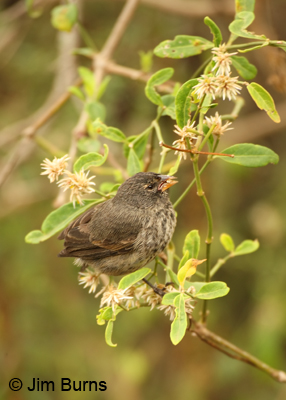
The Blue-footed Booby is a seabird, larger than a gull, that plunge dives for fish from great heights and is best known for its elaborate mating dance which seems all the more fantastical because of the bright pastel color of its feet for which it is named. Blue-footeds nest on the Galapagos and have developed a wonderful gender specific adaptation which allows them to better raise their young. The pupil of the male Blue-footed is a dark dot, small enough on the pale yellow iris that the eye appears pale. The female’s pupil is much larger, dwarfing the size of the iris so that her eye appears dark. Slightly larger than her mate, her larger pupil allows her to fish deeper, darker ocean depths than the male. Thus, together they can take advantage of a greater variety of fish from varying levels of the ocean.
Of course there were no witnesses to this marvelous and gradual adaptation but, remarkably enough, an evolutionary change just as important and much more rapid was actually witnessed and documented in an endemic Galapagos species. Researchers Rosemary and Peter Grant spent several years on one of the islands, Daphne Major, trapping "Darwin's Finches," measuring their beaks, then releasing them, hoping to learn once and for all how the thirteen species evolved different bill sizes and shapes.
A severe drought in 1977 was the jackpot the Grants had hoped to hit. Plants on Daphne Major dried out and the seeds upon which the finches depended disappeared. One of the species, the Medium Ground-Finch, did not breed at all in 1977 and its population on the island fell by 85%. Even in populations of the same species, though, some birds have slightly larger beaks. The 15% of the Medium Ground-Finches that survived were the larger beaked birds able to crack and eat the larger, harder seeds that were left after all the smaller, softer ones were gone.
When the rains returned for the next breeding season the surviving finches passed on their larger-beaked genes and so, in 1978, the Medium Ground-Finches the Grants were trapping all had quantifiably larger beaks than the average of those trapped before the drought! Then the El Nino year, 1982-83, swung the pendulum back, producing an abundance of plants with small, soft seeds followed by a breeding season in which bird populations exploded, quickly outstripping Daphne Major's resources which, in turn, caused finch numbers to plummet again the following year. The larger-beaked finches died off first and average beak size for Medium Ground-Finches once again became smaller.
The Grants had witnessed and documented what Darwin was only able to surmise. Perhaps irrespective of how it all began, or perhaps not, the Grants proved evolution happens and demonstrated how and why new species, new beings, appear on this earth. Call it science, call it magic, call it proof of a Greater Being, this is the allure of the Galapagos Islands. This is a place, as a human being, you just might want to put on your bucket list to experience before you exit the planet.